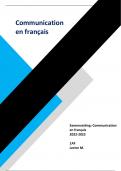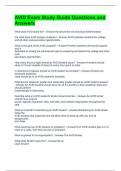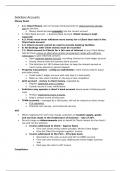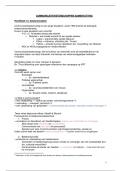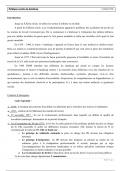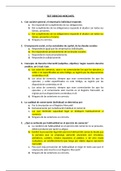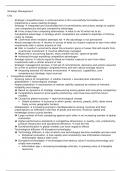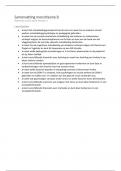Universiteit Antwerpen Schakelprogramma Milieuwetenschappen
Docent: Ilse Loots Stad en Ruimte
STAD EN RUIMTE
Samenvatting
Academiejaar: 2021 - 2022
,
,
,Inhoud Stad en Ruimte
Inhoud
1 Ruimte als hidden dimension ...........................................................................1
1.1 Distances in man (Hall) ...............................................................................1
1.1.1 Proxemic patterns ..................................................................................1
1.1.2 Waarnemingen en zingeving...................................................................2
1.2 Ruimte en samenleving ...............................................................................2
1.2.1 Fysieke systeem .....................................................................................2
1.2.2 Sociale systeem .....................................................................................3
1.2.3 Eigenschappen en gradaties van ruimte .................................................3
1.3 Productie van ruimte ...................................................................................3
1.4 4 key dimensions of socio-spatial relations (Jessop) .....................................4
1.5 Ruimtelijk determinisme .............................................................................5
2 Ruimte en tijd als sociale constructies ..............................................................7
2.1 Geproduceerde ruimte .................................................................................7
2.2 Ruimte als oriëntatiemiddel .........................................................................7
2.2.1 Mental Maps ..........................................................................................8
2.3 The image of the city ...................................................................................9
2.3.1 5 Elementaire bouwstenen in beeld van een stad (ruimte) ......................9
2.4 Soorten kaartvoorstellingen .........................................................................9
2.4.1 Topologisch ...........................................................................................9
2.4.2 Topografisch ..........................................................................................9
2.5 Tijd en ruimte als oriëntatiemiddel ............................................................ 10
2.5.1 Laag abstractieniveau ruimte ............................................................... 10
2.5.2 Hoog abstractieniveau ruimte .............................................................. 10
3 Privaat & Publiek domein ............................................................................... 11
3.1 Pleitbezorgers voor better public spaces ..................................................... 12
3.1.1 Jane Jacobs ........................................................................................ 12
3.1.2 Richard Sennet en Hannah Arendt ...................................................... 12
3.1.3 Lyn Lofland en Maarten Hajer .............................................................. 12
3.2 Publiek domein sociologisch: een triade van sociale ruimtes (L. Lofland) .... 13
3.2.1 Sporen van privatisering ...................................................................... 13
3.2.2 Oorzaken krimpende parochiale sfeer? ................................................. 14
3.2.3 Oorzaken krimpend publiek domein? ................................................... 14
3.2.4 Organized complexity........................................................................... 14
1
, 3.3 Juridisch: een tweedeling .......................................................................... 15
3.3.1 Privaat domein .................................................................................... 15
3.3.2 Openbaar of publiek domein ................................................................ 16
4 Gated Community’s ........................................................................................ 17
4.1 Historiek ................................................................................................... 17
4.2 Typologie ................................................................................................... 17
4.2.1 Typologie VS (Blakely) .......................................................................... 17
4.2.2 Typologie Europa (Smets)..................................................................... 17
4.3 Beheersvormen (governance) ..................................................................... 18
4.3.1 Pseudo lokale besturen in de VS - do-it-yourself gouvernance .............. 18
4.3.2 Polemiek ‘private-public realm’ ............................................................ 18
4.4 Sociaal ruimtelijke kenmerken .................................................................. 20
4.5 Hoe mogelijk in België/Vlaanderen? .......................................................... 20
4.6 ‘Local communities’ of ‘communites of place’ analytisch ............................. 21
4.6.1 The decline/collapse of community ...................................................... 22
4.6.2 Perspectieven op ‘communities of place’ ............................................... 22
5 Van stedelijke mozaïek tot ruimte voor dagelijkse praktijken van diversiteit .... 23
5.1 Geleding in de stedelijke ruimte (Chicago School) ...................................... 24
5.1.1 Natural areas als kernbegrip in de ‘human ecology’ .............................. 24
5.1.2 Socio-demografische geleding............................................................... 24
5.1.3 Functionele differentiatie of subregio’s ................................................. 25
5.2 Geledingsmodellen .................................................................................... 25
5.2.1 Concentrische (homogene) zones (Geledingsmodel 1) ............................ 25
5.2.2 De stadsgewestelijke opbouw ............................................................... 26
5.2.3 Sectoren (Geledingsmodel 2) ................................................................ 27
5.2.4 Meerkernenmodel (Geledingsmodel 3) .................................................. 27
5.3 Evolutie van geledingsstudie ...................................................................... 27
5.4 4 kritieken op ‘natural area’s’ .................................................................... 28
5.4.1 Onderscheid natuurlijke/cultuurlijke processen .................................. 28
5.4.2 Geen homogeniteit in de stedelijke heterogeniteit ................................. 28
5.4.3 Aandacht voor desorganisatie verdrukt de aandacht voor organisatie en
morele code .................................................................................................... 29
5.4.4 Chicago school geen community studies van natural areas maar studie
van interdependentie van specialized subcommunities .................................... 30
5.5 Zoom op ethnografische ‘community studies’ ............................................. 30
2
,Inhoud Stad en Ruimte
6 NIMBY en LULU als locatieconflicten .............................................................. 31
6.1 Drie types vraagstukken (issues) in de ruimtelijke ordening ....................... 31
6.2 Inzichten uit de sociologie.......................................................................... 31
6.2.1 De kern van vele locatievraagstukken en (NIMBY-)reacties ................... 32
6.2.2 Frames: hoe worden conflict, verzet en oplossingen gekaderd? ............. 32
6.2.3 De triade van actoren per dossier ......................................................... 33
6.2.4 NIMBY epidemie?................................................................................. 34
6.3 Oplossingen .............................................................................................. 34
6.3.1 Stigmatisering van NIMBY als dominant discours ................................ 34
6.3.2 Orthodoxe oplossingsstrategieën .......................................................... 34
6.4 NIMBY eigentijds benaderen ...................................................................... 35
6.4.1 Dialoog (argumentatieve besluitvorming) als oplossing ......................... 35
7 Environmental justice: ook in Vlaanderen? ..................................................... 37
7.1 Een sociale beweging ................................................................................. 37
7.2 Een meerzijdig concept .............................................................................. 37
7.3 Een multidisciplinair onderzoeksgebied ..................................................... 38
7.4 Environmental justice en ruimte................................................................ 38
7.5 Klimaatrechtvaardigheid: specifieke eigenschappen? ................................. 39
7.5.1 De ongelijke bijdrage............................................................................ 39
7.5.2 Klimaatrechtvaardigheid: principes en praktijken ................................ 40
7.6 Milieu en klimaatrechtvaardigheid: dus? ................................................... 40
8 Territoriale ordening vs. Ruimtelijk netwerkdenken ........................................ 41
8.1 Vestigingsgedrag van buurtwinkels en -diensten........................................ 42
8.1.1 Een buurtvoorziening vestigt zich territoriaal ....................................... 42
8.1.2 Andere territoriale vestigers ................................................................. 42
8.1.3 De beleidsrelevantie van ‘schaal’ .......................................................... 43
8.2 De hiërarchie van de nederzettingen in een regio of land ............................ 43
8.2.1 Het centrale plaatsen model (Christaller, 1933) .................................... 43
8.2.2 Structuurplan Vlaanderen ................................................................... 45
8.2.3 Types afwentelingsproblemen nopen tot bestuurlijke notie stadsgewesten
en (her)allocaties stad-hinterland .................................................................... 45
8.3 Netwerk-vestiging van typisch ‘stedelijke’ winkels en diensten ................... 46
9 Globalisering en ruimte .................................................................................. 47
9.1 Globalisering als ‘space of flows’ en dominant discours .............................. 48
3
, 9.1.1 Globalisering: een wereldomspannend ‘discours’ van globalisering ....... 48
9.2 Saskia Sassen’s ‘global cities’ .................................................................... 49
9.2.1 Globalisering: globale economie ........................................................... 49
9.2.2 Global cities (wereldsteden) .................................................................. 50
9.3 Voorlopers van global cities? ...................................................................... 51
9.3.1 Middeleeuwse steden als open systeem ................................................ 51
9.3.2 Conclusie: stad niet herleiden tot een ‘grote’ gemeente ......................... 52
9.4 Global cities in ‘rankings’ .......................................................................... 52
9.4.1 Hoe meten? ......................................................................................... 53
9.4.2 Kritiek op stedelijke ranking door Boelens ........................................... 53
9.5 Sassen en neo-marxisme als stedelijke theorie ........................................... 55
9.5.1 Onderscheid met de Chicago School .................................................... 55
9.5.2 Sprekende citaten uit Castell’s werk .................................................... 56
9.5.3 Neo-marxistische auteurs .................................................................... 57
9.6 Klassiek model van de soevereine natiestaat .............................................. 58
9.6.1 De natiestaat ....................................................................................... 58
9.6.2 Nieuwe assemblage van territorium, macht en rechten (o.a. global cities)
58
4
,Samenvatting Stad en Ruimte
1 Ruimte als hidden dimension
Deze les maakt duidelijk dat ruimte tegelijk een verborgen dimensie als heel
omni-present is in onze maatschappelijke ordening en alledaagse praktijken, en
dat op alle niveaus: micro, meso en macro. Op enkele founding fathers na kreeg
de dimensie niet de verdiende aandacht in de vroege sociologie. De
moderniseringsrethoriek in zowel de samenleving als de sociale theorievorming
is daar de verklaring voor.
Vandaag is ‘ruimte’ helemaal niét hidden in de sociologie. Ze staat volop in de
belangstelling en we verkennen op hoofdlijnen welke terminologie ‘ruimte’ als
dimensie zoal meekrijgt.
1.1 Distances in man (Hall)
1.1.1 Proxemic patterns
= patronen van gedrag
• Studie door E.T. Hall
o Interesse in micro studies en interculturele communicatie
o Territoriumgedragsstudies
o Bepalen van culturele verschillen
▪ => ook door culturele overdraagbaarheid van deze patronen
o Beleving van patronen en persoonlijke verschillen
• 4 Hoofdgroepen van 8 distances (telkens close en far phase)
o Intieme afstand
▪ Innerlijke, vertrouwelijke
▪ Zone van jezelf, comfortabel
▪ Voorbeeld: In het Westen is het doorgaans ongepast om in
iemand zijn intieme afstand te komen, in de Arabische wereld
wel (meer) aanvaardbaar
o Persoonlijke afstand
▪ Bufferzone tussen jezelf en de ander = privacy buffer
o Sociale afstand
▪ Interpersoonlijk sociaal verkeer
• Zakelijk/formeel/vreemden
▪ Geen lichamelijk aanvoelen meer van dominantie
• => hulpmiddelen nodig om dominantie uit te drukken
▪ Belang van oogcontact
o Publieke afstand
▪ Publiek optreden = afstand in een publiek
▪ Zintuigelijke beperkingen
▪ Verschillen tussen culturen
1
,1.1.2 Waarnemingen en zingeving
• Er is een voortdurende interactie
tussen het fysieke en sociale afstand
• Zintuigelijke waarneming valt onder
fysiek systeem
o Fysiek systeem bepaalt
afstanden
• Patroonmatigheden
o De afstand is betekenisvol en
wordt door anderen begrepen
o Ook bepaald door sociaal
systeem
▪ Voortdurend aanvoelen van wat past en niet past in een
omgeving = identifiable spatial anachronisms
• Micro: afstanden Halle
• Meso: layout buitencampus
• Macro: grenzen natiestaat, enclaves
o Grenzen en territoria
1.2 Ruimte en samenleving
1.2.1 Fysieke systeem
Stelt voorwaarden
• = Onontkoombare beperkingen
van de fysische ruimte
o Bv: waterlopen
• Medegebruik van ruimte vergt
afspraken
o Ecoservices
o Hydrosolidariteit
Bron van kansen
• = faciliterend, bron van kansen, structurerend
• Medium voor sociale organisatie
o Ruimte is een drager van functies
o Voorbeeld:
▪ Hoogte als status
▪ Fysieke afstanden om sociale afstanden duidelijk te maken
▪ Identificatie met plaatsen = plek
• Ruimte structureert en reproduceert het sociaal systeem
o Recreates = herbevestigen
Niet: Ruimtelijk determinisme (zie verder)
2
, Samenvatting Stad en Ruimte
1.2.2 Sociale systeem
• Voorbeeld: andere autostrade in
India = ander
verplaatsingssysteem
• Armoede, sociale ongelijkheid
worden ook ruimtelijk
gereproduceerd
o Wijken met verschillende
status
o Fysieke scheiding tussen
verschillende statussen
• Ruimtelijke factor reproduceert sociaal systeem
o Ruimtelijke omgeving is spiegel van de samenleving
1.2.3 Eigenschappen en gradaties van ruimte
• Simmel
• 5 Eigenschappen = grondvormen
• Lokaliseerbaarheid
• Begrensbaarheid
• Ruimtelijke Exclusiviteit
o Territorialiteit = macht over een bepaalde zone
• Uitgestrektheid
o Groote van het oppervlak
• Nabijheid en afstand
o Dicht bijeen en ver van elkaar
o Afzondering
o Concentratie / spreiding => hiërarchie
1.3 Productie van ruimte
Hoe wordt ruimte geproduceerd? = constructieprocessen van ruimte
• 3 hoofdtypes
o Politieke constructie: organisatie van politiek en bestuur
o Economische constructie: ruimtelijke organisatie van
productiefactoren en – wijzen en consumptie
o Sociale en culturele constructie: ruimtelijke organisatie van
samenhorigheid en integratie
▪ Inclusie en exclusie
• Wij maken de ruimte zelf
o Ruimte is niet een passieve geografische omgeving
o Ruimte is een ondersteuning van de processen
o Maatschappelijke organisatie
3
Docent: Ilse Loots Stad en Ruimte
STAD EN RUIMTE
Samenvatting
Academiejaar: 2021 - 2022
,
,
,Inhoud Stad en Ruimte
Inhoud
1 Ruimte als hidden dimension ...........................................................................1
1.1 Distances in man (Hall) ...............................................................................1
1.1.1 Proxemic patterns ..................................................................................1
1.1.2 Waarnemingen en zingeving...................................................................2
1.2 Ruimte en samenleving ...............................................................................2
1.2.1 Fysieke systeem .....................................................................................2
1.2.2 Sociale systeem .....................................................................................3
1.2.3 Eigenschappen en gradaties van ruimte .................................................3
1.3 Productie van ruimte ...................................................................................3
1.4 4 key dimensions of socio-spatial relations (Jessop) .....................................4
1.5 Ruimtelijk determinisme .............................................................................5
2 Ruimte en tijd als sociale constructies ..............................................................7
2.1 Geproduceerde ruimte .................................................................................7
2.2 Ruimte als oriëntatiemiddel .........................................................................7
2.2.1 Mental Maps ..........................................................................................8
2.3 The image of the city ...................................................................................9
2.3.1 5 Elementaire bouwstenen in beeld van een stad (ruimte) ......................9
2.4 Soorten kaartvoorstellingen .........................................................................9
2.4.1 Topologisch ...........................................................................................9
2.4.2 Topografisch ..........................................................................................9
2.5 Tijd en ruimte als oriëntatiemiddel ............................................................ 10
2.5.1 Laag abstractieniveau ruimte ............................................................... 10
2.5.2 Hoog abstractieniveau ruimte .............................................................. 10
3 Privaat & Publiek domein ............................................................................... 11
3.1 Pleitbezorgers voor better public spaces ..................................................... 12
3.1.1 Jane Jacobs ........................................................................................ 12
3.1.2 Richard Sennet en Hannah Arendt ...................................................... 12
3.1.3 Lyn Lofland en Maarten Hajer .............................................................. 12
3.2 Publiek domein sociologisch: een triade van sociale ruimtes (L. Lofland) .... 13
3.2.1 Sporen van privatisering ...................................................................... 13
3.2.2 Oorzaken krimpende parochiale sfeer? ................................................. 14
3.2.3 Oorzaken krimpend publiek domein? ................................................... 14
3.2.4 Organized complexity........................................................................... 14
1
, 3.3 Juridisch: een tweedeling .......................................................................... 15
3.3.1 Privaat domein .................................................................................... 15
3.3.2 Openbaar of publiek domein ................................................................ 16
4 Gated Community’s ........................................................................................ 17
4.1 Historiek ................................................................................................... 17
4.2 Typologie ................................................................................................... 17
4.2.1 Typologie VS (Blakely) .......................................................................... 17
4.2.2 Typologie Europa (Smets)..................................................................... 17
4.3 Beheersvormen (governance) ..................................................................... 18
4.3.1 Pseudo lokale besturen in de VS - do-it-yourself gouvernance .............. 18
4.3.2 Polemiek ‘private-public realm’ ............................................................ 18
4.4 Sociaal ruimtelijke kenmerken .................................................................. 20
4.5 Hoe mogelijk in België/Vlaanderen? .......................................................... 20
4.6 ‘Local communities’ of ‘communites of place’ analytisch ............................. 21
4.6.1 The decline/collapse of community ...................................................... 22
4.6.2 Perspectieven op ‘communities of place’ ............................................... 22
5 Van stedelijke mozaïek tot ruimte voor dagelijkse praktijken van diversiteit .... 23
5.1 Geleding in de stedelijke ruimte (Chicago School) ...................................... 24
5.1.1 Natural areas als kernbegrip in de ‘human ecology’ .............................. 24
5.1.2 Socio-demografische geleding............................................................... 24
5.1.3 Functionele differentiatie of subregio’s ................................................. 25
5.2 Geledingsmodellen .................................................................................... 25
5.2.1 Concentrische (homogene) zones (Geledingsmodel 1) ............................ 25
5.2.2 De stadsgewestelijke opbouw ............................................................... 26
5.2.3 Sectoren (Geledingsmodel 2) ................................................................ 27
5.2.4 Meerkernenmodel (Geledingsmodel 3) .................................................. 27
5.3 Evolutie van geledingsstudie ...................................................................... 27
5.4 4 kritieken op ‘natural area’s’ .................................................................... 28
5.4.1 Onderscheid natuurlijke/cultuurlijke processen .................................. 28
5.4.2 Geen homogeniteit in de stedelijke heterogeniteit ................................. 28
5.4.3 Aandacht voor desorganisatie verdrukt de aandacht voor organisatie en
morele code .................................................................................................... 29
5.4.4 Chicago school geen community studies van natural areas maar studie
van interdependentie van specialized subcommunities .................................... 30
5.5 Zoom op ethnografische ‘community studies’ ............................................. 30
2
,Inhoud Stad en Ruimte
6 NIMBY en LULU als locatieconflicten .............................................................. 31
6.1 Drie types vraagstukken (issues) in de ruimtelijke ordening ....................... 31
6.2 Inzichten uit de sociologie.......................................................................... 31
6.2.1 De kern van vele locatievraagstukken en (NIMBY-)reacties ................... 32
6.2.2 Frames: hoe worden conflict, verzet en oplossingen gekaderd? ............. 32
6.2.3 De triade van actoren per dossier ......................................................... 33
6.2.4 NIMBY epidemie?................................................................................. 34
6.3 Oplossingen .............................................................................................. 34
6.3.1 Stigmatisering van NIMBY als dominant discours ................................ 34
6.3.2 Orthodoxe oplossingsstrategieën .......................................................... 34
6.4 NIMBY eigentijds benaderen ...................................................................... 35
6.4.1 Dialoog (argumentatieve besluitvorming) als oplossing ......................... 35
7 Environmental justice: ook in Vlaanderen? ..................................................... 37
7.1 Een sociale beweging ................................................................................. 37
7.2 Een meerzijdig concept .............................................................................. 37
7.3 Een multidisciplinair onderzoeksgebied ..................................................... 38
7.4 Environmental justice en ruimte................................................................ 38
7.5 Klimaatrechtvaardigheid: specifieke eigenschappen? ................................. 39
7.5.1 De ongelijke bijdrage............................................................................ 39
7.5.2 Klimaatrechtvaardigheid: principes en praktijken ................................ 40
7.6 Milieu en klimaatrechtvaardigheid: dus? ................................................... 40
8 Territoriale ordening vs. Ruimtelijk netwerkdenken ........................................ 41
8.1 Vestigingsgedrag van buurtwinkels en -diensten........................................ 42
8.1.1 Een buurtvoorziening vestigt zich territoriaal ....................................... 42
8.1.2 Andere territoriale vestigers ................................................................. 42
8.1.3 De beleidsrelevantie van ‘schaal’ .......................................................... 43
8.2 De hiërarchie van de nederzettingen in een regio of land ............................ 43
8.2.1 Het centrale plaatsen model (Christaller, 1933) .................................... 43
8.2.2 Structuurplan Vlaanderen ................................................................... 45
8.2.3 Types afwentelingsproblemen nopen tot bestuurlijke notie stadsgewesten
en (her)allocaties stad-hinterland .................................................................... 45
8.3 Netwerk-vestiging van typisch ‘stedelijke’ winkels en diensten ................... 46
9 Globalisering en ruimte .................................................................................. 47
9.1 Globalisering als ‘space of flows’ en dominant discours .............................. 48
3
, 9.1.1 Globalisering: een wereldomspannend ‘discours’ van globalisering ....... 48
9.2 Saskia Sassen’s ‘global cities’ .................................................................... 49
9.2.1 Globalisering: globale economie ........................................................... 49
9.2.2 Global cities (wereldsteden) .................................................................. 50
9.3 Voorlopers van global cities? ...................................................................... 51
9.3.1 Middeleeuwse steden als open systeem ................................................ 51
9.3.2 Conclusie: stad niet herleiden tot een ‘grote’ gemeente ......................... 52
9.4 Global cities in ‘rankings’ .......................................................................... 52
9.4.1 Hoe meten? ......................................................................................... 53
9.4.2 Kritiek op stedelijke ranking door Boelens ........................................... 53
9.5 Sassen en neo-marxisme als stedelijke theorie ........................................... 55
9.5.1 Onderscheid met de Chicago School .................................................... 55
9.5.2 Sprekende citaten uit Castell’s werk .................................................... 56
9.5.3 Neo-marxistische auteurs .................................................................... 57
9.6 Klassiek model van de soevereine natiestaat .............................................. 58
9.6.1 De natiestaat ....................................................................................... 58
9.6.2 Nieuwe assemblage van territorium, macht en rechten (o.a. global cities)
58
4
,Samenvatting Stad en Ruimte
1 Ruimte als hidden dimension
Deze les maakt duidelijk dat ruimte tegelijk een verborgen dimensie als heel
omni-present is in onze maatschappelijke ordening en alledaagse praktijken, en
dat op alle niveaus: micro, meso en macro. Op enkele founding fathers na kreeg
de dimensie niet de verdiende aandacht in de vroege sociologie. De
moderniseringsrethoriek in zowel de samenleving als de sociale theorievorming
is daar de verklaring voor.
Vandaag is ‘ruimte’ helemaal niét hidden in de sociologie. Ze staat volop in de
belangstelling en we verkennen op hoofdlijnen welke terminologie ‘ruimte’ als
dimensie zoal meekrijgt.
1.1 Distances in man (Hall)
1.1.1 Proxemic patterns
= patronen van gedrag
• Studie door E.T. Hall
o Interesse in micro studies en interculturele communicatie
o Territoriumgedragsstudies
o Bepalen van culturele verschillen
▪ => ook door culturele overdraagbaarheid van deze patronen
o Beleving van patronen en persoonlijke verschillen
• 4 Hoofdgroepen van 8 distances (telkens close en far phase)
o Intieme afstand
▪ Innerlijke, vertrouwelijke
▪ Zone van jezelf, comfortabel
▪ Voorbeeld: In het Westen is het doorgaans ongepast om in
iemand zijn intieme afstand te komen, in de Arabische wereld
wel (meer) aanvaardbaar
o Persoonlijke afstand
▪ Bufferzone tussen jezelf en de ander = privacy buffer
o Sociale afstand
▪ Interpersoonlijk sociaal verkeer
• Zakelijk/formeel/vreemden
▪ Geen lichamelijk aanvoelen meer van dominantie
• => hulpmiddelen nodig om dominantie uit te drukken
▪ Belang van oogcontact
o Publieke afstand
▪ Publiek optreden = afstand in een publiek
▪ Zintuigelijke beperkingen
▪ Verschillen tussen culturen
1
,1.1.2 Waarnemingen en zingeving
• Er is een voortdurende interactie
tussen het fysieke en sociale afstand
• Zintuigelijke waarneming valt onder
fysiek systeem
o Fysiek systeem bepaalt
afstanden
• Patroonmatigheden
o De afstand is betekenisvol en
wordt door anderen begrepen
o Ook bepaald door sociaal
systeem
▪ Voortdurend aanvoelen van wat past en niet past in een
omgeving = identifiable spatial anachronisms
• Micro: afstanden Halle
• Meso: layout buitencampus
• Macro: grenzen natiestaat, enclaves
o Grenzen en territoria
1.2 Ruimte en samenleving
1.2.1 Fysieke systeem
Stelt voorwaarden
• = Onontkoombare beperkingen
van de fysische ruimte
o Bv: waterlopen
• Medegebruik van ruimte vergt
afspraken
o Ecoservices
o Hydrosolidariteit
Bron van kansen
• = faciliterend, bron van kansen, structurerend
• Medium voor sociale organisatie
o Ruimte is een drager van functies
o Voorbeeld:
▪ Hoogte als status
▪ Fysieke afstanden om sociale afstanden duidelijk te maken
▪ Identificatie met plaatsen = plek
• Ruimte structureert en reproduceert het sociaal systeem
o Recreates = herbevestigen
Niet: Ruimtelijk determinisme (zie verder)
2
, Samenvatting Stad en Ruimte
1.2.2 Sociale systeem
• Voorbeeld: andere autostrade in
India = ander
verplaatsingssysteem
• Armoede, sociale ongelijkheid
worden ook ruimtelijk
gereproduceerd
o Wijken met verschillende
status
o Fysieke scheiding tussen
verschillende statussen
• Ruimtelijke factor reproduceert sociaal systeem
o Ruimtelijke omgeving is spiegel van de samenleving
1.2.3 Eigenschappen en gradaties van ruimte
• Simmel
• 5 Eigenschappen = grondvormen
• Lokaliseerbaarheid
• Begrensbaarheid
• Ruimtelijke Exclusiviteit
o Territorialiteit = macht over een bepaalde zone
• Uitgestrektheid
o Groote van het oppervlak
• Nabijheid en afstand
o Dicht bijeen en ver van elkaar
o Afzondering
o Concentratie / spreiding => hiërarchie
1.3 Productie van ruimte
Hoe wordt ruimte geproduceerd? = constructieprocessen van ruimte
• 3 hoofdtypes
o Politieke constructie: organisatie van politiek en bestuur
o Economische constructie: ruimtelijke organisatie van
productiefactoren en – wijzen en consumptie
o Sociale en culturele constructie: ruimtelijke organisatie van
samenhorigheid en integratie
▪ Inclusie en exclusie
• Wij maken de ruimte zelf
o Ruimte is niet een passieve geografische omgeving
o Ruimte is een ondersteuning van de processen
o Maatschappelijke organisatie
3

